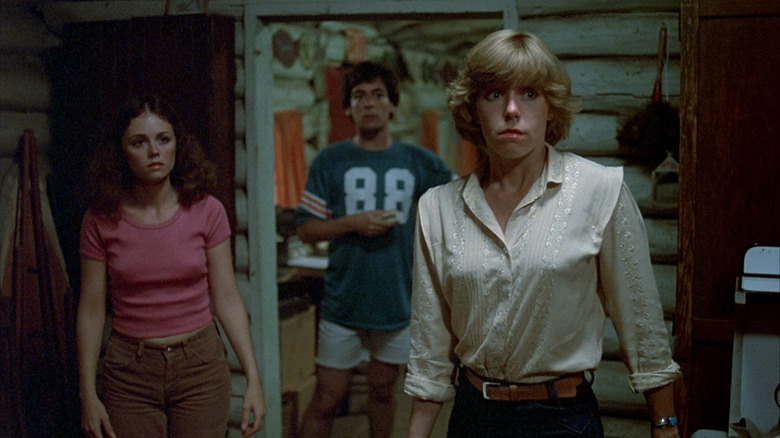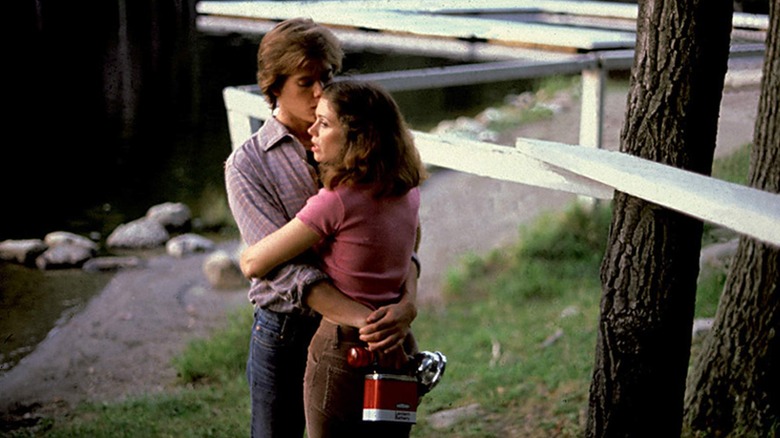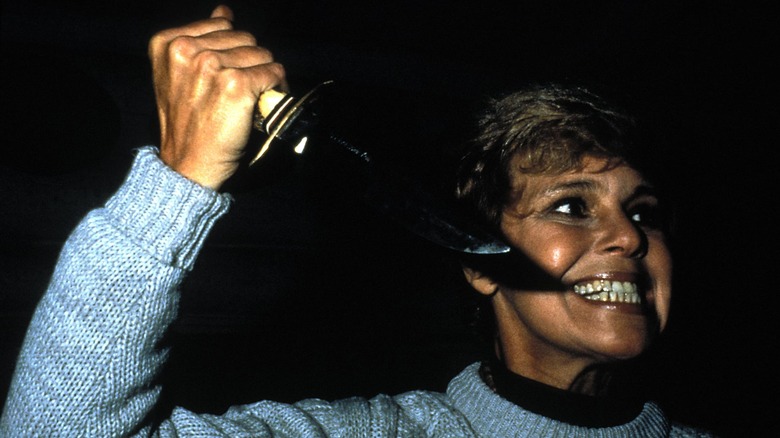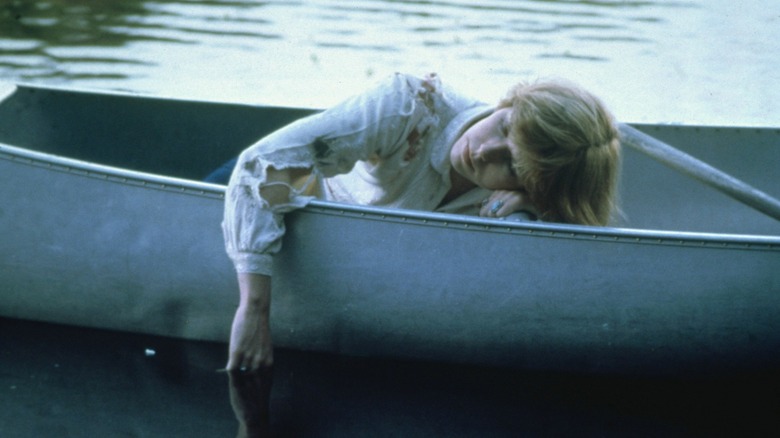The Scariest Scene In The Original Friday The 13th Is Truly Iconic
(Welcome to Scariest Scene Ever, a column dedicated to the most pulse-pounding moments in horror with your tour guides, horror experts Matt Donato and Ariel Fisher. In this edition: Matt gets back to basics with an iconic "Friday the 13th" scare, and Ariel talks about its lasting terror.)
Ariel tickled my remake itch last week, which got the proverbial wheels turning. There's always someone, somewhere, preaching that all remakes are worthless — pay these complainers no mind, their rants are baseless. But still, as someone who's spent eons defending remake culture, specifically in the horror genre, my brain can't leave these tirades alone. "Friday the 13th" (2009) was my entry point into the entire franchise, which I'm not ashamed of, and in no way ruined any of the preceding "classics" despite those lies spread by nostalgia clutchers.
I'll resurrect 1980's "Friday the 13th" only a week removed from Ariel's selection of the remake (sequel, really) because there's a scare that has become an often replicated staple stinger. A boat, a moment of calm, a forgotten boy. It's an ambiguous ending that could become infamous should "Friday the 13th" ever sort out its legal troubles, because if one party gains sole custody of the rights, they can't use the Jason that comes after the disfigured child seen at Camp Crystal Lake. There's so much history in that one lakewater shot, none of which was ruined by a remake decades later.
It's all still there, fully appreciated whether you start in the aughts or grew up watching Jason Voorhees slash through theater screens. Remakes aren't the problem — try looking in the mirror.
The Setup
Do we ... are we doing this? It's "Friday the 13th." The one where Pamela Voorhees (Betsy Palmer) gets revenge on hormonal camp counselors who'd rather canoodle than pay attention to the welfare of youthful attendees. Jason Voorhees is a supporting character whose death in 1957 is the impetus for Pamela's slaughter spree. Alice (Adrienne King) survives as the pivotal final girl only to be unceremoniously slaughtered as an introduction to "Friday the 13th: Part II."
You know the movie.
Or, maybe you don't? Which is fine! My purpose of revealing that 2009's "Friday the 13th" served as my introduction to Jason Voorhees is to stress how everyone's journey into fandom is uniquely curated. It's twenty-one years later at Camp Crystal Lake, after "an unknown boy's" death (Jason), and counselors are arriving to reopen the tainted woodlands. Annie (Robbi Morgan) is the first to bite it, as she's left hiking to find an entrance and is killed in the process. No GPS, no smartphones, no chance.
The Story So Far
Counselors who've already begun tidying the disheveled Camp Crystal Lake have no idea that Annie was just murdered off the premises. A thunderstorm approaches shortly after and threatens to impede their productivity. Owner Steve Christy (Peter Brouwer) leaves his crew alone to stock supplies. There's no supervision and less motivation, so the remaining Camp Crystal Lake staff do what they do best — seek privacy for sexy times.
Cue the cavalcade of fornication, slasher stalks, and mutilation. Jack (Kevin Bacon) lays in bed only to have his throat pierced with an arrow. Marcie (Jeannine Taylor) takes an axe to the face. Alice worries about her colleagues and does some sleuthing, only to rush back into the main cabin after discovering corpses. That's when Brenda's (Laurie Bartram ) body smashes through the window — limp and lifeless — followed by the arrival of a vehicle's headlights. Mrs. Voorhees enters under the guise of being acquaintances with Steve and his family, only to reveal her son Jason's death, thus outing the maternal madwoman as the killer.
Alice and Pamela throw down on the shore as a machete flails with violent intentions. Alice gains the upper hand and decapitates Pamela, thus defeating the film's prominent evil. Little does she know ... well, here's the next section.
The Scene
Alice boards a canoe and lets herself float into the middle of the lake, showing signs of exhaustion. She falls asleep, comforted by Mrs. Voorhees' death. There's a serenity to it all. Alice is suspended in time, regaining consciousness when a policeman shouts from the banks.
She gazes into the calm waters, presumably replaying the tragic events of the previous night. Harry Manfredini's score begins to crescendo in celebration, almost like a parade is about to arrive. Alice's hand skims the water, and she swirls it around in a daze. The camera zooms in closer and closer, capturing a girl who's overcome by the weight of her trauma.
All signs point to a happy ending. She's done it. She's survived.
The camera continues to zoom at a steady pace, and that's when it happens — a rotting, decomposing figure leaps up from behind Alice into her vessel. It's Jason, risen after two decades. His arm, caked with lake sediment, wraps around Alice and drags her downward, back into the water, as Manfredini's score flips from optimistic to the screechy wails of string instruments that have now become the "Jason Attack Alarm." Alice screams; her nightmare continues — until she awakens in a hospital bed, with doctors who assure "everything's over."
It's such a nasty trick to play on the audience, whether referencing the jump scare or "all a dream" gotcha. The problem is, "Friday the 13th" executes the jolt with precision. Theatergoers have no choice but to leap upon their first encounter with the moment, and other filmmakers took note. Well, maybe not enough note because there's rarely been a comparable recreation outside of "Hatchet" (a movie built on homages). It's the gold standard of such assaults and will be replicated long after we're all buried six feet beneath Jason's latest victims.
The Impact (Ariel's Take)
This scene is an absolute classic. And it always makes me think of the conclusion to Brian De Palma's "Carrie" in 1976. I'm not sure if it was the first slasher to utilize this kind of jump scare, but it's definitely one of the most iconic. What "Carrie" and "Friday the 13th" both accomplished, admittedly to varying degrees of success (particularly as time goes on), is an analogy for a broken way of thinking about trauma. De Palma arguably emphasizes it a bit better than Sean S. Cunningham, but the sentiment remains the same; you can't just bury your trauma and hope it'll go away. It doesn't. It will find you, and it will destroy you.
There was a prevailing notion at the time in North America in certain circles that therapy was for the weak, trauma is an excuse not to succeed, and if you just ignore grief and don't acknowledge it, it'll go away. You'll forget about it. It's what Sue Snell's mom said on the phone before she woke up screaming ("Well, he said that she's young enough that she'll forget all about it in time.") and it's the implication we get from Alice's nightmare. There's a desire to believe you're safe. Now that the situation is over, that's all there is. But that's the most terrifying part of trauma — it can happen quickly, but it lingers for a long time.
Alice feels safe in her dream. She's being rescued while she's floating safely away from any possible looming threats. And then it grabs her. The terror takes hold and drags her down. Nowhere is safe, not even your own mind.
This is one of the single most iconic jump scares of all time. And while they were a little softer and gentler then than they are now, it still packs a shocking punch, particularly on first viewing. That said, for me, it's the implications of the scene that are truly terrifying and the hardest to grapple with.



